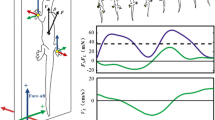Abstract
Cats are characterized by their excellent landing ability. During the landing, they extend and bend their flexible backs. This study was undertaken to examine the effect of flexible back on impact attenuation. We collected kinematic and ground reaction force data from cats performing self-initiated jump down at different heights. Based on these measurements, the mechanical energy and elastic back energy were calculated. Further, we derived a beam model to predict back stiffness from the morphology of the vertebral spines. We found that cat could actively modulate the bending level of flexible back and the landing angle at different heights, making some kinetic energy be stored briefly as elastic strain energy in the back. This mechanism allows cat to reduce the kinetic energy dissipated by limbs and improve the efficiency of energy absorption. These results can provide biological inspiration for the design of a flexible spine on a landing robot, and we anticipated their use in the energy absorption equipments for planetary exploration.
Similar content being viewed by others
References
Hildebrand M. Motions of the running cheetah and horse. Journal of Mammalogy, 1959, 40, 481–495.
Gambaryan P P. How Mammals Run, John Wiley, New York, USA, 1974.
Koob T J, Long J H. The vertebrate body axis: evolution and mechanical function. American Zoologist, 2000, 40, 1–18.
Hildebrand M. Analysis of asymmetrical gaits. Journal of Mammalogy, 1977, 58, 131–156.
Alexander R M, Langman V A, Jayes A S. Fast locomotion of some African ungulates. Journal of Zoology, 1977, 183, 291–300.
Hildebrand M. The quadrupedal gaits of vertebrates. Bio-Science, 1989, 39, 766–775.
Smith J L, Chung S H, Zernicke R F. Gait-related motor patterns and hindlimb kinetics for the cat trot and gallop. Experimental brain research, 1993, 94, 308–322.
Bertram J E, Gutmann A. Motions of the running horse and cheetah revisited: fundamental mechanics of the transverse and rotary gallop. Journal of the Royal Society Interface, 2009, 6, 549–559.
English A W. The functions of the lumbar spine during stepping in the cat. Journal of Morphology, 1980, 165, 55–66.
Hackert R, Schilling N, Fischer M S. Mechanical self-stabilization, a working hypothesis for the study of the evolution of body proportions in terrestrial mammals? Comptes Rendus Palevol, 2006, 5, 541–549.
Maes L D, Herbin M, Hackert R, Bels V L, Abourachid A. Steady locomotion in dogs: temporal and associated spatial coordination patterns and the effect of speed. Journal of Experimental Biology, 2008, 211, 136–149.
Alexander R M, Jayes D A. Estimates of the bending moments exerted by the lumbar and abdominal muscles of some mammals. Journal of Zoology, 1980, 194, 291–303.
Alexander R M, Dimery N J, Ker R F. Elastic structures in the back and their role in galloping in some mammals. Journal of Zoology, 1985, 207, 467–482.
Alexander R M. Why mammals gallop. American Zoologist, 1988, 28, 237–245.
Fischer M S. Crouched posture and high fulcrum, a principle in the locomotion of small mammals: the example of the rock hyrax (Procavia capensis) (Mammalia: Hyracoidea). Journal of Human Evolution, 1994, 26, 501–524.
Schilling N, Hackert R. Sagittal spine movements of small therian mammals during asymmetrical gaits. Journal of Experimental Biology, 2006, 209, 3925–3939.
Biancardi C M, Minetti, A E. Biomechanical determinants of transverse and rotary gallop in cursorial mammals. Journal of Experimental Biology, 2012, 215, 4144–4156.
Hudson P E, Corr S A, Wilson A M. High speed galloping in the cheetah (Acinonyx jubatus) and the racing greyhound (Canis familiaris): Spatiotemporal and kinetic characteristics. Journal of Experimental Biology, 2012, 215, 2425–2434.
Wilson A M, Lowe J C, Roskilly K, Hudson P E, Golabek K A, Mcnutt J W. Locomotion dynamics of hunting in wild cheetahs. Nature, 2013, 498, 185–189.
Kane T R, Scher M P. A dynamical explanation of the falling cat phenomenon. International Journal of Solids and Structures, 1969, 5, 663–670.
Liu Y Z. On the turning motion of a free-falling cat. Acta Mechanica Sinica, 1982, 18, 388–393. (in Chinese)
Diamond J M. Why cats have nine lives. Nature, 1988, 332, 586–587.
Zhang Z Q, Yu H, Yang J L, Wang L L, Yang L M. How cat lands: insights into contribution of the forelimbs and hindlimbs to attenuating impact force. Chinese Science Bulletin, 2014, 59, 3325–3332.
Cavagna G A. Force platforms as ergometers. Journal of applied physiology, 1975, 39, 174–179.
Fung Y C. Biomechanics Mechanical Properties of Living Tissues, 2nd ed, Springer, New York, 2004.
Alexander R M. Elastic energy stores in running vertebrates. American Zoologist, 1984, 24, 85–94.
Santello M. Review of motor control mechanisms underlying impact absorption from falls. Gait and Posture, 2005, 21, 85–94.
Author information
Authors and Affiliations
Corresponding author
Rights and permissions
About this article
Cite this article
Zhang, Z., Yang, J. & Yu, H. Effect of Flexible Back on Energy Absorption during Landing in Cats: A Biomechanical Investigation. J Bionic Eng 11, 506–516 (2014). https://doi.org/10.1016/S1672-6529(14)60063-9
Published:
Issue Date:
DOI: https://doi.org/10.1016/S1672-6529(14)60063-9



